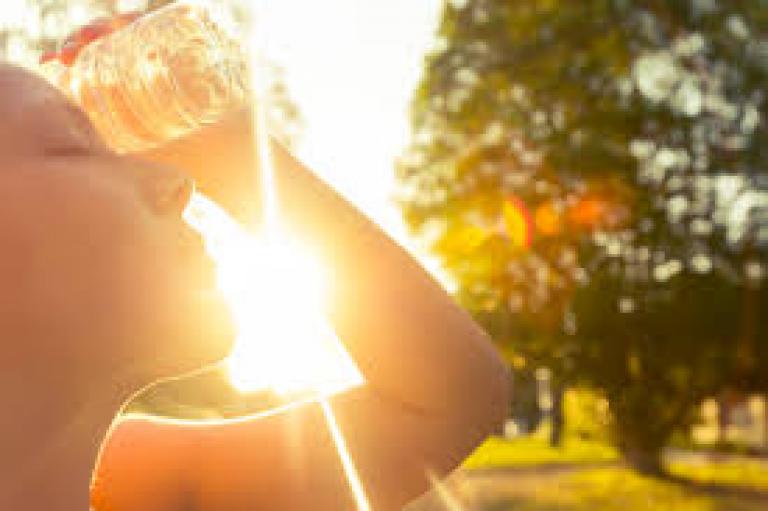In connection with the high temperatures during the summer season, the Ministry of Health reminds citizens that the most at risk of sunstroke are adults over 60 and children, as well as people with cardiovascular disease and people with obesity. To protect themselves, people should stay in the shade, especially at noon, protect themselves from direct sunlight, wear a hat in the city and use a beach umbrella on the beach, wear cotton and light clothing, drink more fluids, not to drink alcohol during the day, to avoid physical activity, summer vacationers not to stay on the beach between 11 and 14 hours. In case of sunstroke, patients are transported to the shade and cold compresses are placed on their heads.
Signs of sunstroke and heat stroke
The difference between heat stroke and sunstroke is that heat stroke can occur not only in the sun. The most unpleasant complication is that it stops sweating due to dehydration, unlike sunstroke, in which sweating is preserved. Heat stroke can occur when working in warm and humid rooms, in stuffy weather and high humidity and outdoors. Under such conditions, it is difficult to release heat from the body to the environment. . Predisposing factors for this are strenuous physical activity on a full stomach, alcohol consumption, wearing thick and closed clothes, as well as the presence of cardiovascular disease and obesity.
The signs of sunstroke and heat stroke are similar. There are headaches, flushing, profuse sweating, rapid and difficult breathing, fatigue, nausea or vomiting, dizziness and ringing in the ears. In more severe forms, loss of consciousness, hallucinations and seizures occur.
Symptoms of heat stroke
The symptoms of heat stroke in its initial phase are fatigue, headache, nausea, vomiting, involuntary trembling of individual muscle groups (cramps). In the next phase, there is a violation of tone and consciousness to the point of heat stroke and a sharp rise in body temperature to values above physiological. There is a general reddening of the skin without sweating. It is important to note that if left untreated, this condition can lead to respiratory arrest and death.
Paramedic help
First aid for heat or sunstroke should be provided quickly, regardless of the degree of damage. The victim is transferred to a cool, shady and ventilated place, placed in a semi-sitting position, the clothes are loosened, it is necessary to spray with water and put a cold compress on the head. Wet towels are also placed on the victim’s chest, abdomen and back and he is given cold water to drink. If the victim is able to drink fluids, he is given plenty of chilled and sweetened drinks. In case of loss of consciousness and cessation of breathing and heart activity, artificial respiration and indirect cardiac massage are performed. The victim was transported lying down to a medical facility.
First aid for heat stroke
It is applied after the effect of heat has been previously isolated. Cooling is undertaken only after removing the clothes, wrapping with a squeezed damp sheet, rubbing the body with a wet cold towel or sponge, placing bags and bottles of cold water and ice under the arms, groin and abdomen. If the victim is unconscious and there is a medical professional nearby, the body temperature is lowered by intravenous infusion of chilled physiological serum or by injection of analgin / antiallerzine, intramuscularly.
If the victim is conscious, it is necessary to take sweetened and cooled liquids. When working in very humid and warm rooms, regular intake of carbonated water is necessary.
Emergency medical care
In any case, in case of need for emergency care in a situation of heat or sunstroke, the needy should contact the emergency departments of the nearest medical institution or in case of impossibility or remoteness of the medical institution – to the regional centers of emergency medical care common European emergency number 112 introduced by Directive 2002/20 / EC of the European Parliament and of the Council of Europe and of 2008 in all Member States.













 English
English French
French Spanish
Spanish German
German Dutch
Dutch Italian
Italian Danish
Danish Portuguese
Portuguese Greek
Greek Russian
Russian Swedish
Swedish Bulgarian
Bulgarian Hungarian
Hungarian Catalan
Catalan Ukrainian
Ukrainian Polish
Polish Basque
Basque Chinese (Simplified)
Chinese (Simplified) Japanese
Japanese Hebrew
Hebrew Arabic
Arabic Swahili
Swahili Amharic
Amharic Irish
Irish Afrikaans
Afrikaans Albanian
Albanian Armenian
Armenian Azerbaijani
Azerbaijani Belarusian
Belarusian Bengali
Bengali Bosnian
Bosnian Cebuano
Cebuano Chichewa
Chichewa Chinese (Traditional)
Chinese (Traditional) Corsican
Corsican Croatian
Croatian Czech
Czech Esperanto
Esperanto Estonian
Estonian Filipino
Filipino Finnish
Finnish Frisian
Frisian Galician
Galician Georgian
Georgian Gujarati
Gujarati Haitian Creole
Haitian Creole Hausa
Hausa Hawaiian
Hawaiian Hindi
Hindi Hmong
Hmong Icelandic
Icelandic Igbo
Igbo Indonesian
Indonesian Javanese
Javanese Kannada
Kannada Kazakh
Kazakh Khmer
Khmer Korean
Korean Kurdish (Kurmanji)
Kurdish (Kurmanji) Kyrgyz
Kyrgyz Lao
Lao Latin
Latin Latvian
Latvian Lithuanian
Lithuanian Luxembourgish
Luxembourgish Macedonian
Macedonian Malagasy
Malagasy Malay
Malay Malayalam
Malayalam Maltese
Maltese Maori
Maori Marathi
Marathi Mongolian
Mongolian Myanmar (Burmese)
Myanmar (Burmese) Nepali
Nepali Norwegian
Norwegian Pashto
Pashto Persian
Persian Punjabi
Punjabi Romanian
Romanian Samoan
Samoan Scottish Gaelic
Scottish Gaelic Serbian
Serbian Sesotho
Sesotho Shona
Shona Sindhi
Sindhi Sinhala
Sinhala Slovak
Slovak Slovenian
Slovenian Somali
Somali Sundanese
Sundanese Tajik
Tajik Tamil
Tamil Telugu
Telugu Thai
Thai Turkish
Turkish Urdu
Urdu Uzbek
Uzbek Vietnamese
Vietnamese Welsh
Welsh Xhosa
Xhosa Yiddish
Yiddish Yoruba
Yoruba Zulu
Zulu